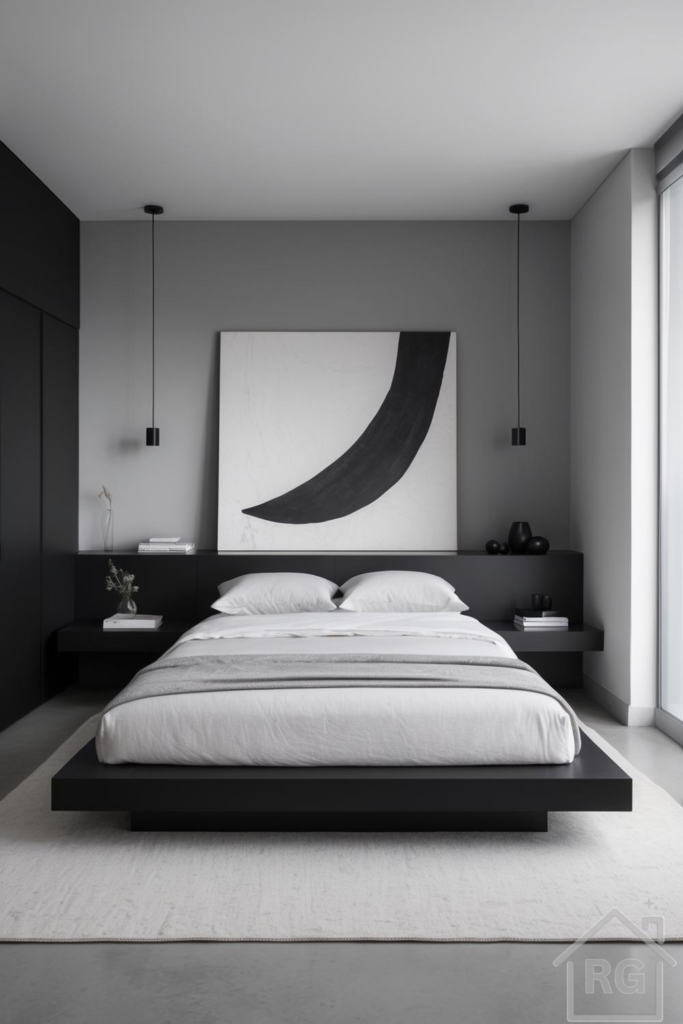
Embracing the Serenity of Monochrome Minimalist Design
In a world brimming with visual noise and constant stimulation, the bedroom should serve as a sanctuary – a place of calm, rest, and rejuvenation. The minimalist monochrome aesthetic, beautifully exemplified in serene spaces, offers a powerful antidote to clutter and chaos. By embracing a restrained palette of black, white, and various shades of gray, you can create a sophisticated, tranquil, and timeless retreat that promotes deep relaxation and clarity of mind. This guide will walk you through the principles and practical steps to achieve such a harmonious design in your own home.
The Power of a Limited Palette: Black, White, and Gray
The foundation of any minimalist bedroom lies in its carefully curated color scheme. Far from being stark or uninviting, the intelligent use of black, white, and gray creates depth, contrast, and a sense of sophisticated calm. Let’s explore how each color contributes to this serene environment.
- Black: The Anchor of Sophistication. Deep, inky black is used for striking elements like the platform bed, integrated headboard, and built-in wardrobe. Black provides a grounding presence, defining architectural elements and furniture with a bold, confident statement. It absorbs light, creating a sense of intimacy and depth, and its matte finish prevents it from feeling overwhelming, instead lending a soft, velvety touch.
- White: The Breath of Fresh Air. Crisp white bedding acts as a luminous counterpoint to dark elements. White reflects light, making the space feel expansive and airy. It signifies cleanliness, purity, and simplicity, inviting you to sink into its fresh embrace. Large abstract artwork often utilizes a soft white background, allowing bold black strokes to truly pop.
- Gray: The Harmonious Bridge. Walls painted in a cool, mid-tone gray serve as the perfect intermediary between dramatic black and pristine white. Gray is incredibly versatile; it can be calming, sophisticated, and contemporary all at once. It provides a subtle backdrop that allows furniture and art to stand out without harsh contrast. A soft, light gray area rug further softens the floor, adding another layer of gentle texture and warmth.
The key to mastering this palette is to layer different shades and tones within each color family. Think of a spectrum from charcoal to dove gray, from pure white to soft ivory, and from deep ebony to lighter charcoal. This thoughtful layering prevents the room from feeling flat and adds visual interest without introducing new colors, maintaining the serene monochrome aesthetic.
Furniture as Form: Sleek Lines and Integrated Design
In minimalist design, furniture isn’t just functional; it’s sculptural. Each piece is chosen for its clean lines, simple form, and often, its multi-functional capabilities. This approach minimizes clutter and maximizes visual harmony.
- The Platform Bed: A low-slung, dark platform bed is a quintessential minimalist choice. Its simple, unadorned frame creates a sense of spaciousness and modernity. By eliminating the need for a bulky box spring, it maintains a sleek profile that grounds the room without dominating it.
- Integrated Headboard and Nightstands: Custom-built headboards that seamlessly extend into floating nightstands are a hallmark of sophisticated minimalism. This integrated design reduces visual clutter, provides discreet surfaces for essentials, and creates a cohesive, architectural statement, eliminating the need for separate bedside tables.
- Built-in Wardrobe: A flush, dark wardrobe that blends almost invisibly into the room’s design is ideal. Built-in storage is crucial in minimalist spaces as it allows for maximum organization and keeps personal items out of sight, maintaining the room’s serene appearance.
When selecting furniture, prioritize quality over quantity. Choose pieces with simple, geometric shapes and smooth, unembellished surfaces. The beauty in minimalist furniture lies in the purity of form and the absence of unnecessary ornamentation.
The Art of Texture: Adding Depth and Warmth
Without a vibrant color palette, texture becomes paramount in adding richness, warmth, and sensory appeal to a monochrome room. It’s how the room feels as much as how it looks, preventing the space from feeling cold or sterile.
- Soft Textiles: Crisp white cotton duvets and pillows, paired with a soft gray throw blanket, invite tactile exploration. These textiles provide comfort and a sense of luxurious softness against the harder surfaces of the furniture. Consider linen, wool, or cashmere for additional textural layers.
- Area Rug: A light gray area rug beneath the bed adds significant warmth and defines the sleeping zone. Its subtle pattern or weave adds another layer of visual interest without introducing busyness, and provides a soft landing for bare feet.
- Smooth Finishes: The matte finish of furniture, like a bed frame and headboard, contrasts beautifully with soft textiles. This smooth, non-reflective surface contributes to the room’s calm and sophisticated ambiance.
- Natural Elements: Even subtle touches like smooth glass vases or the organic texture of a small plant sprig introduce natural textures that soften the overall aesthetic.
Lighting as Art: Illuminating with Intention
Lighting in a minimalist bedroom is both functional and decorative. It should enhance the mood, highlight the room’s architectural features, and contribute to the overall serene atmosphere.
- Pendant Lights: Slender black pendant lights, for example, are perfect examples of minimalist lighting. They act as sculptural elements, providing focused illumination without taking up valuable surface space. Their simple form complements the clean lines of the room.
- Natural Light: Ample natural light is essential for a bright and airy feel, even with a dark color scheme. Large windows are key. Consider sheer blinds or curtains if privacy is needed, to maintain the light flow.
- Ambient Lighting: Incorporate hidden LED strips or dimmable recessed lighting to create a soft, ambient glow for evening relaxation, adding depth and warmth.
Art and Accessories: Curated Simplicity
In a minimalist space, every accessory must earn its place. The goal is not to fill the room, but to enhance it with carefully chosen, impactful pieces that contribute to the overall aesthetic and feeling of calm.
- Statement Art: A large abstract painting can be the room’s focal point. Its bold black stroke against a white background, for instance, echoes the room’s color scheme and adds a dynamic, artistic element without being overly decorative. Choose art that resonates with you and complements the room’s mood.
- Minimalist Decor: Decorative vases and ceramic bowls should be few but impactful. Their simple forms and dark tones can blend seamlessly with furniture, adding subtle texture and visual interest without creating clutter. A small vase with a single sprig of foliage introduces a touch of organic life and softness.
- Books: A few carefully stacked books can add a personal touch and a hint of intellectual curiosity, while still maintaining the clean aesthetic.
Practical Tips for Achieving the Look
- Declutter Ruthlessly: This is the golden rule of minimalism. Remove anything that doesn’t serve a purpose or bring you joy. Invest in smart storage solutions to keep surfaces clear and maintain visual calm.
- Invest in Quality: Because there are fewer items, the quality of each piece becomes more apparent. Choose well-made furniture and textiles that will stand the test of time and contribute to the room’s sophisticated feel.
- Layer Textures: Compensate for the limited color palette by introducing a variety of textures – soft, smooth, matte, woven – to add depth and warmth, preventing the room from feeling flat.
- Embrace Negative Space: Allow for plenty of empty space around furniture and on walls. This "breathing room" is essential for a calm, uncluttered feel and allows key pieces to stand out.
- Maintain Cleanliness: A minimalist room thrives on order. Regular tidying and cleaning are crucial to preserving its serene atmosphere and visual appeal.
- Consider Custom Built-ins: If your budget allows, integrated furniture like custom headboards and wardrobes can dramatically enhance the minimalist aesthetic and functionality, reducing visual clutter.
Conclusion: Your Personal Sanctuary
Creating a minimalist monochrome bedroom is an exercise in intentional design. It’s about stripping away the superfluous to reveal the essential, focusing on quality, form, and the interplay of light and shadow. The result is a space that feels incredibly sophisticated, deeply calming, and profoundly personal. By following these principles, you can transform your bedroom into a tranquil sanctuary where peace of mind and restful sleep are always within reach. Embrace the quiet elegance of black, white, and gray, and discover the profound beauty of simplicity in your home.
